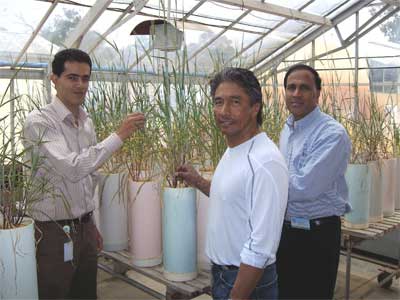|
April 22, 2008
Quantifying how well cereals, such
as barley and wheat, can tolerate drought can be a measure of
their true value to dryland agricultural systems, such as those
in Western Australia and Iran.
Although hemispheres apart, there are similarities and some of
these were recently assessed by Iranian PhD scholar Shahab
Maddah-Hosseini while in Western Australia on a six month ATSE
Crawford Fund training award from August 2007 to January 2008.
Supervised by The University of
Western Australia (UWA) Chair in Agriculture and Director of
the Institute of Agriculture,
Professor Kadambot Siddique and CSIRO Plant Industry Principal
Research Scientist, Dr Jairo Palta, he found that grain filling,
and therefore yield, in barley under terminal drought
conditions, varied according to variety.
 |
|
(L to
R) Iranian PhD candidate Shahab Maddah-Hosseini, Dr
Jairo Palta of CSIRO and Professor Kadambot Siddique of
UWA discuss the contribution of awns to grain filling in
different barley varieties under terminal drought in the
glasshouse at CSIRO. |
He discovered that photosynthesis
of the awns (part of the ear) was greater than of the flag leaf
in some of the Australian barley varieties Clipper, Corvette,
Stirling, Gairdner, Baudin and Vlamingh.
According to Professor Siddique, these finding have implications
for breeding barley cultivars to dryland environments,
especially as a strategy for adapting to climate change, which
is already having an impact on Australia and Iran.
UWA’s Research Station in Shenton Park has more than 11,000
lines, comprising wild types, landraces, varieties and breeding
lines, in its general barley collection.
The 30 year old UWA barley germplasm enhancement project has
contributed to the development of several successful barely
varieties in WA and nationally, most recently providing parental
lines used in the breeding of the malting variety Vlamingh
launched in February 2006.
Dr Palta said Mr Shahab Maddah-Hosseini’s training in WA
focussed on glasshouse experiments to determine the role of the
vegetative parts of the ear, particularly the awns, in providing
carbon assimilates for grain filling in barley under terminal
soil water deficits.
“The experiments were designed to allow him to learn about
glasshouse facilities, particularly controlled temperature and
humidity, methods to induce and measure water deficit,
techniques to measuring photosynthesis in the vegetative parts
of the ear and measuring and analysing dry matter
remobilisation,” Dr Palta said.
Mr Maddah-Hosseini visited sites at Geraldton, Morawa, Wongan
Hills, Brookton and Merredin in the WA grainbelt, where trials
and crops of barley, wheat, legumes and oilseeds were grown.
This allowed him to observe field experimental systems and
techniques used to evaluate adaptation of barley and wheat
genotypes in areas limited by water and nitrogen.
Professor Siddique and Dr Palta said skills developed by Mr
Maddah-Hosseini in WA would directly benefit his PhD research
project at the Department of Agronomy and Plant Breeding,
University of Tehran, Karaj, Iran.
Mr Maddah-Hosseini’s discussions and interaction with
supervisors, mentors and researchers at CSIRO and UWA would also
help him generate new research ideas on drought tolerance of
cereals in Iran.
“For Australia, his work will help future barley breeding
programs in terms of specifically targeting traits for superior
adaptation to drying climatic conditions,” Professor Siddique
said.
“As his experimental glasshouse data requires further analysis,
he will maintain regular contact with his supervisors at UWA and
CSIRO.
“Once this analysis is completed, we will help Mr
Maddah-Hosseini prepare a manuscript for submission and
publication in an international scientific journal.
“His visit to WA has strengthened UWA’s relationship with the
University of Tehran,” Professor Siddique said. |
|